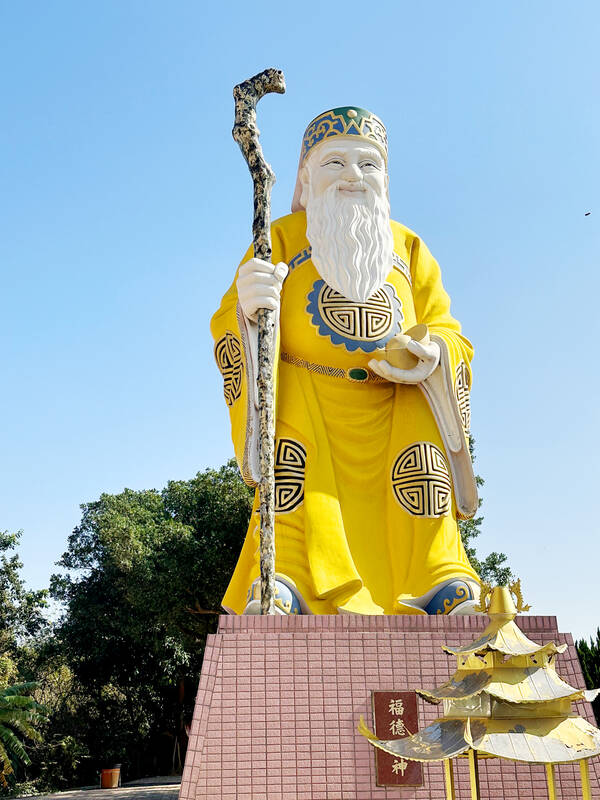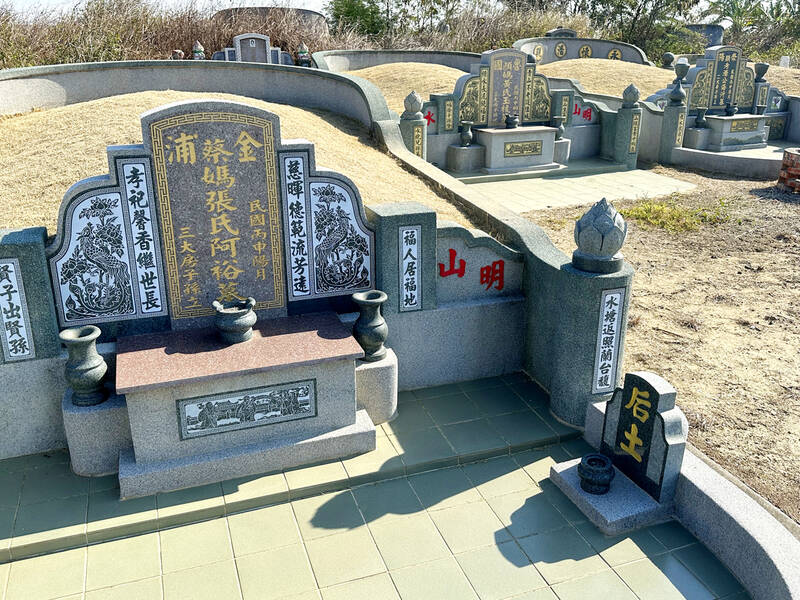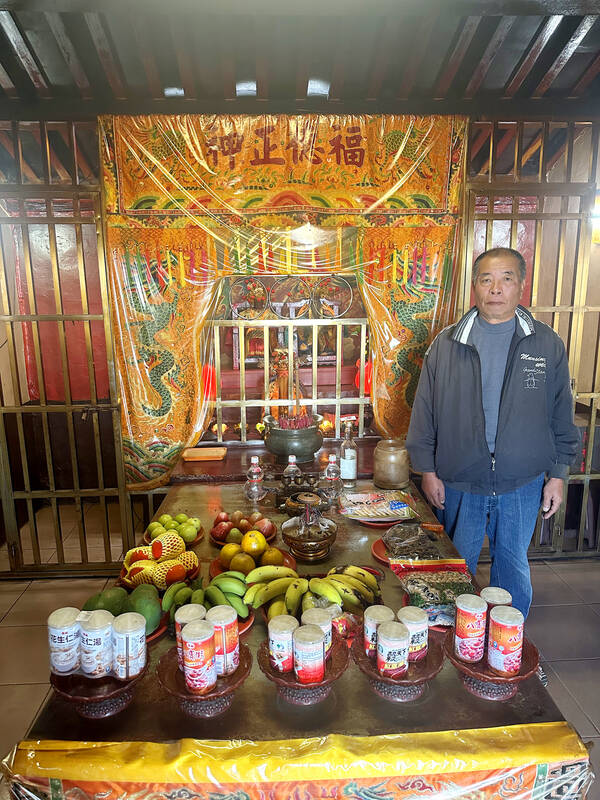My wife awoke one morning with a curious exclamation: “I saw a snake in my dream. I need to go and pray to Tudi Gong.” It turns out there’s a widespread belief that seeing a snake in a dream is a premonition of misfortune. The “dreamer” should worship at the local Tudi Gong temple as soon as possible to avert disaster.
Tudi Gong’s association with snakes reflects his guardianship over the soil (tu) and his protection of a place (di). Although gong is translated as “god,” it’s more useful to think of Tudi Gong as the patron saint of an area.
Tudi Gong is best known perhaps by the roadside shrines, often adjacent to fields, which are distinctive by their diminutive size — some barely waist height and others with the dimensions of a tool shed, but the statues are found everywhere: in households, stores, in almost every Taoist temple as a secondary deity and sometimes in his own temple. Large statues stand guard over columbaria (buildings storing funeral urns) and smaller statues over individual gravestones.

Photo: John Ross
COMMON DEITY
Tudi Gong is the most common deity in Taiwan, yet is very little written about. So, one weekday, I decided to jump on my scooter and explore around my hometown of Puzi in Chiayi County. First stop was local historian Chen Chun-je (陳俊哲), who knows every ruin, rock and tree in the small rural city. He said that Tudi Gong is the spiritual equivalent of a “borough warden,” the guardian responsible for a particular area, taking care of that neighborhood.
He straddles the realms of yin and yang, providing protection for both the dead and the living, and helping with the growth of crops and the prosperity of businesses. Although subordinate to the city god, and, in fact, the lowest ranked of the deities, Tudi Gong is important.

Photo: John Ross
“Because of his humble rank and friendly personality, he knows the people well and is willing to help with their requests,” Chen said.
Like a borough warden, a Tudi Gong has a particular, demarcated territory of responsibility.
“People on one side of a street will worship at this shrine or temple, but neighbors across the street, they will worship at another one,” Chen said.

Photo: John Ross
But there are exceptions.
“You know that very small shrine in the railway park, it was relocated there, and it can be worshipped by anyone,” he said.
I dropped by for a look afterward, finding a statue housed in a meter-high shrine alongside a tree, in the shade of which Food Panda dispatch riders awaited their next deliveries.

Photo: John Ross
This kind of small shrine with the deity on the ground is less common today. He’s been moved into larger, more comfortable shrines, typically given a big chair atop an altar and decorated in elaborate robes.
On Chen’s suggestion I went looking for the oldest Tudi Gong shrine in the neighborhood, one from the 1700s, in a village a few minutes down the road. With his directions “the police station is on one side of the village and the Tudi Gong shrine on the other, both looking after the area,” I found a rebuilt shrine, with multiple Tudi Gongs, one on an altar out front and others behind metal bars.
Tudi Gong is occasionally accompanied by his wife, Tudi Po, and more often by Huye, the tiger deity, usually found, as he was here, under the main altar.
The shrine used his official name, Fude Zhengshen (福德正神, “Right God of Blessing and Virtue”), which is much more common at shrines than Tudi Gong. As well as multiple names, his various appearances add to the confusion. It’s often difficult to distinguish him from other deities, and also from his helpers.
‘DISPELLING FRIGHT’
On my tour of the countryside investigating Tudi Gong shrines and temples, I came upon a Fude Zhengshen temple, its incense-smoke-blackened interior a sign of its popularity, where a young woman was having some unpleasantness exorcised and a few others awaiting their turn. This is a common folk treatment known in Mandarin as shoujing (“dispelling fright”). When someone feels spooked — by something like a close shave on the roads or a panic attack — a simple ritual is performed by an exorcist waving incense sticks in front of the seated person and chanting special words.
In this case, the exorcist was in plainclothes rather than high Taoist priest costume, but, despite the matter-of-fact nature of this exorcism, it was still a serious endeavor, so I quietly stepped passed them without asking questions, lit six sticks of incense and prayed silently at the various altars and then burnt some spirit money at the outdoor burner.
During my ride around the countryside, the waist-high Tudi Gong shrines proved rare; most of these have been upgraded — local people showing their appreciation to him by giving him better accommodation.
There were some false sightings: some small ground-level shrines turned out to be for a “general.” The richest findings were in the cemeteries, where virtually every tomb has a Tudi Gong statue on the side or even a tiny shrine for him. Those that don’t will have a stone tablet inscribed with the characters houtu (后土).
Houtu is the Earth Goddess, an archaic form of Tudi Gong. Such gender shape-shifting speaks to the origins of Tudi Gong stemming from the dawn of agriculture and very early worship of the earth and its dual associations with life and death.
With the smiling old man proving such a complicated, elusive fellow, I had a long chat with PhD candidate James Morris, who has spent over seven years documenting more than 700 Tudi Gong shrines in Taiwan.
Speaking of Tudi Gong’s connection to ancient ideas beyond Chinese religion, Morris explains that Tudi Gong is a deity expressing a universal idea that various locations on the land have natural spiritual importance.
“In some locations Tudi Gong shrines may reflect a location that was sacred to the indigenous communities, and was assimilated into the dominant Han Chinese cosmology. The worship of other earth-bound deities in Taiwan like stone gods or tree gods is another example of this.”
My wife’s visit to the Tudi Gong temple worked — at least, no snake-foretold misfortune befell her — but my brief explorations of the Earth God have left me with as many questions as which I started.
John Ross is co-founder of Camphor Press, author of Taiwan in 100 Books, and co-host of the Formosa Files podcast.

On April 26, The Lancet published a letter from two doctors at Taichung-based China Medical University Hospital (CMUH) warning that “Taiwan’s Health Care System is on the Brink of Collapse.” The authors said that “Years of policy inaction and mismanagement of resources have led to the National Health Insurance system operating under unsustainable conditions.” The pushback was immediate. Errors in the paper were quickly identified and publicized, to discredit the authors (the hospital apologized). CNA reported that CMUH said the letter described Taiwan in 2021 as having 62 nurses per 10,000 people, when the correct number was 78 nurses per 10,000

As we live longer, our risk of cognitive impairment is increasing. How can we delay the onset of symptoms? Do we have to give up every indulgence or can small changes make a difference? We asked neurologists for tips on how to keep our brains healthy for life. TAKE CARE OF YOUR HEALTH “All of the sensible things that apply to bodily health apply to brain health,” says Suzanne O’Sullivan, a consultant in neurology at the National Hospital for Neurology and Neurosurgery in London, and the author of The Age of Diagnosis. “When you’re 20, you can get away with absolute

May 5 to May 11 What started out as friction between Taiwanese students at Taichung First High School and a Japanese head cook escalated dramatically over the first two weeks of May 1927. It began on April 30 when the cook’s wife knew that lotus starch used in that night’s dinner had rat feces in it, but failed to inform staff until the meal was already prepared. The students believed that her silence was intentional, and filed a complaint. The school’s Japanese administrators sided with the cook’s family, dismissing the students as troublemakers and clamping down on their freedoms — with

As Donald Trump’s executive order in March led to the shuttering of Voice of America (VOA) — the global broadcaster whose roots date back to the fight against Nazi propaganda — he quickly attracted support from figures not used to aligning themselves with any US administration. Trump had ordered the US Agency for Global Media, the federal agency that funds VOA and other groups promoting independent journalism overseas, to be “eliminated to the maximum extent consistent with applicable law.” The decision suddenly halted programming in 49 languages to more than 425 million people. In Moscow, Margarita Simonyan, the hardline editor-in-chief of the